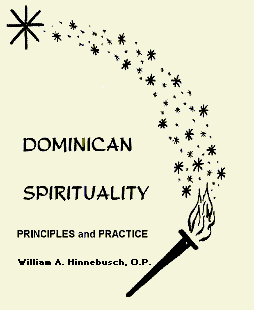|
DOMINICAN SPIRITUALITY
Principles
By |
 |
FOREWORD
Most of this book originated in a series of conferences to the Dominican Sisters of the Congregation of the Most Holy Cross, Amityville, New York, at Dominican Commercial High School, Jamaica, L. I., during the Lent of 1962. All the conferences have been rewritten with some minor deletions and the addition of considerable new material. The first chapter is added as a general introduction to Dominican life to serve as a unifying principle for the rest of the book.
I have also adapted the material to the needs of a wider reading audience. No longer do I address the sister but the Dominican. While some matter applies specifically to nuns or sisters, the use of masculine nouns and pronouns elsewhere by no means indicates that I am addressing only the members of the First Order. Though the forms and methods of their spiritual life vary to some degree ( especially that of the secular tertiary), all Dominicans share the same basic vocation and follow the same spiritual path.
I must thank the sisters of the Amityville community for their interest in the conferences, the sisters of Dominican Commercial High School for taping and mimeographing them, the fathers and the sisters of other Congregations who suggested that a larger audience might welcome them. I am grateful to the fathers especially of the Dominican House of Studies, Washington, D. C., who counselled me, discussed doctrinal points with me, and, by their urging encouraged me to make the revision and prepare the material for publication. A word of thanks is owed to Sister Mary of the Compassion, O.P., of Our Lady of the Rosary Monastery, Summit, N. J., for permission to use her illustrations of St. Dominic. My friend, Miss Elsie Fillo, an apostolic tertiary, has been most faithful and competent in typing the manuscript. The following publishers have kindly permitted me to quote from their books: P. J. Kenedy and Sons from Raymond of Capuas Life of St. Catherine o f Sierra, The Priory Press from Henry Suso's Exemplar, and Helicon Press from Fosters Life of Saint Thomas Aquinas, Biographical Documents. The translation of the lyric of Sister Sourire's Dominiqueis used with permission.
W.A.H.
May 1, 1965
Washington, D. C.
INTRODUCTION
In this day when men and women are earnestly searching for authenticity and relevance in their own lives as well as in the Church in order to be more effective witnesses of Christ in the world, we as Dominicans must also seriously investigate our own origins, so that we too might use all our talents to serve the Church. For this is the purpose of our existence, to worship God according to a particular mode of life approved by the Church and thereby realize our own personal sanctification and the specific end for which we were founded.
It is only by a constant renewal of ourselves that we can even hope to realize the ideal given to us by our holy Father St. Dominic. Renewal is not just a matter of new external forms of activity but should rather affect one's interior disposition and attitude. We must adapt ourselves to change and at the same time enter more deeply into the spirit of St. Dominic. The pages that follow give us a penetrating view of Dominican life. I think this book will be warmly received because of the great lack of such spiritual works in English. Furthermore, it makes its appearance at an appropriate time when the religious life is being severely criticized and its validity in the modern world being challenged.
In reading any book about Dominican spirituality, there is always a danger of our unconsciously seeking refuge and comfort in a romanticized past rather than facing up to the problems of the contemporary situation in which we find ourselves. This dichotomy creates tension when there is little or no relationship between the real and the ideal order of things. We must constantly work to bridge the gap so that we will be imitating St. Dominic in spirit and in truth. There is really no need for Dominicans to protest their loyalty to our heritage. Good will is presumed but it is necessary for us to take a step further; to live the Dominican ideal to the best of our ability in whatever apostolic activity we have been assigned to perform. In the concrete, this is the only way in which we can realize our usefulness in Christ and make a positive contribution to the continued growth of the Church. May we, with the help of God's grace, strive to measure up to the ideal and reflect an authentic image of St. Dominic in our lives.
R. L. EVERY, O.P.
Provincial, St. Joseph Province
April 20, 1965
| Nihil obstat: Rev. Paul K. Meagher, O.P. Censor Deputatus |
Imprimatur: + Patrick A. O'Boyle Archbishop of Washington |
| The nihil obstat and imprimatur are official declarations that a book or pamphlet is free of doctrinal or moral error. No implication is contained therein that those who have granted the nihil obstat and the imprimatur agree with the content, opinions or statements expressed. | |
| Library of Congress Catalog Card Number 64-66421 December 10, 1964 © Copyright 1965 |
THE THOMIST PRESS Printed in the United States of America |
NEXT